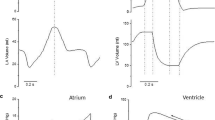Summary
The development of the ventricular conducting tissue of the embryonic chicken heart has been studied using a previous finding that morphologically recognizable atrial conducting tissue coexpresses the atrial and the ventricular myosin isoforms. It is found that, by these criteria, at 9 days part of the ventricular conduction system consists of a myocardial ring located around the infundibula of the aorta and truncus pulmonalis. Part of this ring is formed by the retro-aortic root branch. The ring continues via the septal branch into the atrioventricular bundle and its branches, that all express both myosin isoforms. The retroaortic root branch could be traced back as a part of the myocardial wall of the truncus arteriosus at the 4 days embryonic stage.
At the 16th day of development, the septal branch, atrioventricular bundle and left and right bundle branches no longer express the atrial isomyosin, but two bundles originating from the septal branch still express both isomyosins, one being the retro-aortic root branch, the other being only immunologically recognizable and directed to the ventral side of the truncus pulmonalis; this latter we call the pulmonary root branch. Both bundles are remnants of the myocardial ring.
Similar content being viewed by others
References
Anderson RH (1985) New information about the atrioventricular conduction axis. Int J Cardiol 7:19–20
Anderson RH, Becker AE, Wenink ACG, Janse MJ (1976) The development of the cardiac specialized tissue. In: Wellens HJJ, Lie KI, Janse MJ (eds) The conduction system of the heart. Structure, function and clinical implications. Stenfert Kroese, Leiden pp 3–28
Benninghoff A (1923) Über die Beziehungen des Reizleitungssystems unter den Papillarmuskeln zu den Konturfasern des Herzschlauches. Anat Anz [Suppl] 57:185–208
Burnette WN (1981) “Western blotting”: electrophoretic transfer of proteins from sodium dodecyl sulfate poly-acrylamide gels to unmodified nitrocellulose and radio-iodinated protein. Anal Biochem 112:195–203
Dalla Libera L, Sartore S, Schiaffino S (1979) Comparative analysis of chicken atrial and ventricular myosins. Biochim Biophys Acta 581:283–294
Davies F (1930) The conducting system of the bird's heart. J Anat 54:129–145
Gonzalez-Sanchez A, Bader D (1985) Characterization of a myosin heavy chain in the conductive system of the adult and developing chicken heart. J Cell Biol 100:270–275
Gorza L, Sartore S, Schiaffino S (1982) Myosin types and fiber types in cardiac muscle. II. Atrial myocardium. J Cell Biol 95:838–845
Gossrau R (1969) Topographische und histologische Untersuchungen am Reitzleitungssystem von Vögeln. Z Anat Entwickl.-Gesch 128:163–184
Groot IJM de, Hardy GPMA, Sanders E, Los JA, Moorman AFM (1985) The conducting tissue in the adult chicken atria: a histological and immunochemical analysis. Anat Embryol 172:239–245
Johnstone PN (1971) Studies on the physiological anatomy of the embryonic heart. Thomas, Springfield, Ill, pp 1–19
Jong F de (1984) New transparant 3-D reconstruction techniques and their application to analysis of heart morphogenesis. Acta Morphol Neerl-Scand (abstr) 22:160
Kim Y, Yasuda M (1980) Development of the cardiac conducting system in the chick embryo. Anat Histol Embryol (Berlin) 9:7–20
Kurosawa H, Becker AE (1985) Dead-end tract of the conduction axis. Int J Cardiol 7:13–18
Laane H-M (1974) The nomenclature of the arterial pole of the embryonic heart. Acta Morphol Neerl-Scand 12:195–210
Manasek FJ (1969) Electron microscopic contribution to conduction development. Proc Cond Devl Conf. The national heart and lung institute, Bethesda, Md: 3–27
Sanders E, Moorman AFM, Los JA (1984) The local expression of adult chicken heart myosins during development. I. The three days embryonic chicken heart. Anat Embryol 169:185–191
Sartore S, Pierobon-Bormioli S, Schiaffino S (1978) Immunohistochemical evidence for myosin polymorphism in the chicken heart. Nature 274:82–83
Sartore S, Gorza L, Pierobon-Bormioli S, Dalla Libera L, Schiaffino S (1981) Myosin types and fiber types in cardiac muscle. I. Ventricular myocardium. J Cell Biol 88:226–233
Schook P (1980) A spatial analysis of the localization of cell division and cell death in relationship with the morphogenesis of the chick optic cup. Acta Morphol Neerl-Scand 18:213–229
Vassall-Adams PR (1982) The development of the atrioventricular bundle and its branches in the avian heart. J Anat 134:169–183
Wenink ACG (1976) Development of the human cardiac conducting system. J Anat 121:517–531
Author information
Authors and Affiliations
Rights and permissions
About this article
Cite this article
Sanders, E., de Groot, I.J.M., Geerts, W.J.C. et al. The local expression of adult chicken heart myosins during development. Anat Embryol 174, 187–193 (1986). https://doi.org/10.1007/BF00824334
Accepted:
Issue Date:
DOI: https://doi.org/10.1007/BF00824334




